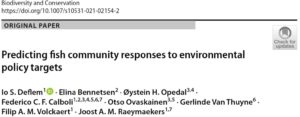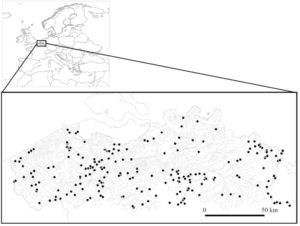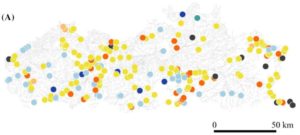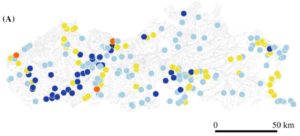Happy to share some new policy-relevant findings, just published in Biodiversity and Conservation (https://link.springer.com/article/10.1007/s10531-021-02154-2)!

People working with aquatic biodiversity and habitat quality in Europe are probably familiar with the EU Water Framework Directive. The WFD proposes biological, hydromorphological, and physico-chemical habitat quality criteria that need to be achieved to reach or maintain a “good” or “very good” environmental status of aquatic habitats. But how are these different criteria connected?
In our study, we predicted how fish communities (= the biological level) in Flanders (Belgium) respond to hydromorphological and physico-chemical quality targets. We did so across the entire territory of Flanders, i.e. at a scale that is directly relevant for policy. To do so, we made use of long-term fish monitoring data from the Research Institute for Nature and Forest (INBO), and long-term environmental monitoring data from the Flemish Environmental Agency (VMM).

Based on these data, we made a species distribution model, describing which regions within the study area provide suitable habitat for each fish species. We used a so-called joint species distribution model, i.e. an approach which can do so for multiple species at the same time.
To identify successful policy implementation and management actions, we first used the model to describe the present situation, and then altered the model to predict the response of fish communities to specific policy scenarios.
Our results revealed that targeting a “good” environmental status increases species diversity with only a fraction of species (< 1 on average). This weak response was mostly associated with improvements of the river bed (the yellow sites in the figure below), i.e. a hydromorphological quality target.

The increase in species richness was more pronounced when targeting a “very good” environmental status. This improvement was primarily induced by decreasing nitrogen levels and conductivity (the dark blue and light blue sites in the figure below), i.e. two physico-chemical quality targets.

Together, the results indicate that improvements can only be achieved by working on multiple targets simultaneously, suggesting a challenging future for river restoration in Flanders. Long-term monitoring datasets are crucial to keep track of the quality of the environment and the diversity of the fish community. The integration of these large datasets provide a powerful tool to evaluate policy decisions.
Congrats Io Deflem with this great study and 1st PhD chapter! Thanks to Elina Bennetsen, Oystein Opedal, Federico Calboli, Otso Ovaskainen, Gerlinde Van Thuyne and Filip Volckaert for the collaboration. And thanks to the Research Institute for Nature and Forest (@INBOVlaanderen) and the Flemish Environmental Agency (@VMMbe) for providing indispensable fish monitoring and environmental data.